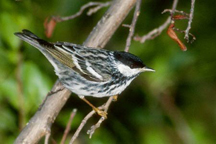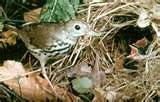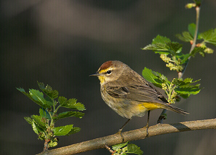
Blackpoll Warbler
|
Fall is an exciting time for birdwatchers on Grand Bahama because many of our feathered winter visitors arrive from their breeding grounds up north. In fact, some of the songbirds, the tiny warblers, travel over 3000 miles to get here.
Scientists don’t know exactly how the migrating birds find their way over long distances, but they are discovering that birds use a variety of navigational aids. They use mountain ranges and coastlines. They set their flight path by the sun and the stars and possibly by the lines of force in the earth’s magnetic field. How the tiny bird brains process these cues is a marvel of nature!
More than 50 species of Warblers migrate south from North America and Canada in the fall. Many of these pass through Grand Bahama on their way to wintering grounds in South America and almost 20 species find our island so attractive that they spend the winter here. There are trees and bushes and forest floor for foraging for insects which is the main food source for warblers. Warblers represent a wonderful natural, environmentally friendly pest control for our island.
Blackpoll Warblers breed as far north as Labrador and the northeast United States. They migrate almost 3000 miles to Brazil and Argentina at altitudes that can reach 21000 feet. They are smaller than sparrows and may stop to feed and rest in Bermuda or the Bahamas during their long flight over water. It is a special treat for Grand Bahama birders to observe Blackpoll Warblers during fall and spring migration. They are only in transit when they visit our island and may spend a few days to rest and feed.

Oven Bird
|
Ovenbirds spend the winter on Grand Bahama. They are usually seen foraging for insects and worms on the ground. Their walk is more like a strut and they are one of the largest Warbler species. They have a very distinct white eyeing and bold black and orange stripes on top of their head. They derive the name “Ovenbird” from the way they construct their nest. It is shaped like an old-fashioned oven on the ground with an entrance hole in the front.
Palm Warblers are also winter residents on Grand Bahama and they are abundant all over the island, even around town. They are the most easily recognizable Warblers – they usually hop around on the ground picking up the tiniest insects while constantly bobbing their tails. A yellow patch can be seen underneath the tail.

Palm Warbler
|
During this migratory period Grand Bahama’s resident bird population may increase to over 200 species and birders travel from many parts of the United States and Canada to enjoy sightings that they might never see at home. On these cooler fall days they will hike through our endemic Caribbean Pineforest hoping to see the Bahamas Nuthatch, the shady hardwood coppice in search of the berry-eating Antillean Bullfinch, or along one of our peaceful wetlands where they might catch a glimpse of a Sora, the shy member of the Rail family.
Yes, fall is a special time for birders everywhere, but it is best on Grand Bahama Island!
Erika Gates – Bird Talk:
owner of Kayak Nature Tours (one of the first Eco-Tour businesses in The Bahamas); co-founder of the Ecotourism Association; a published writer; and a Cacique award winner! Her column Bird Talk will enlighten and educate us about birds of The Bahamas, as well as the importance of Ecology. Erika can be reached at
gbntours@hotmail.com or (242) 373-2485
